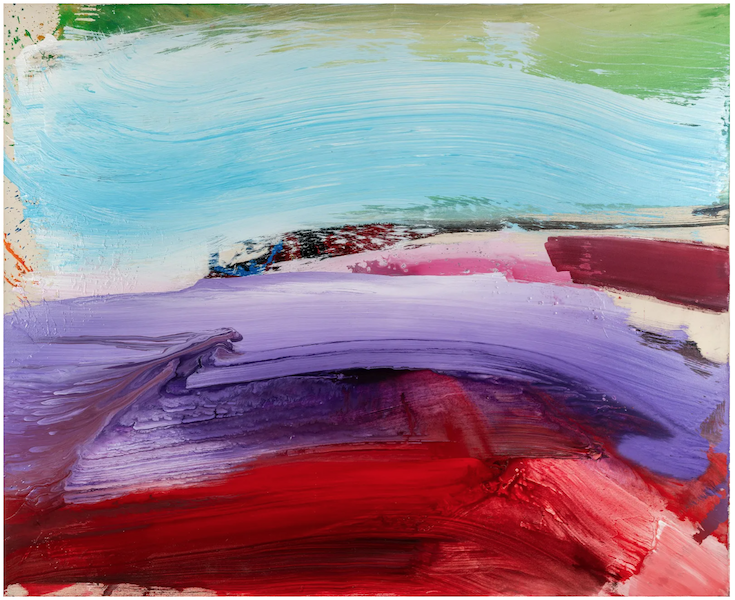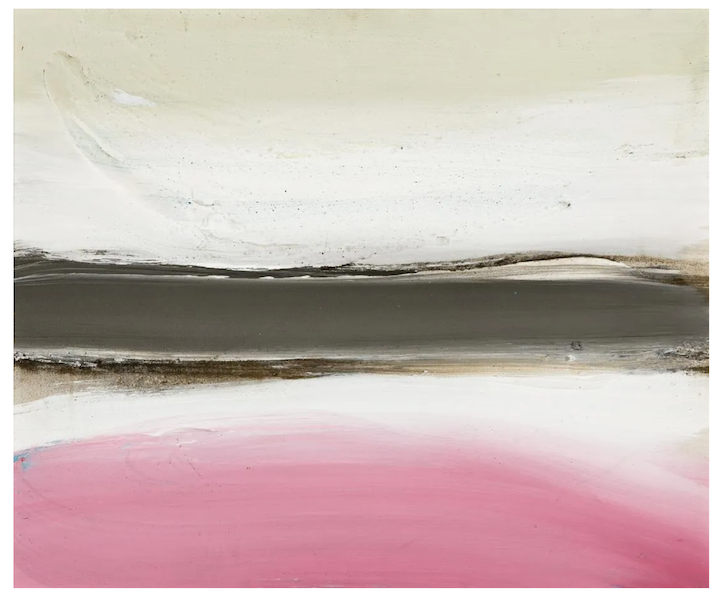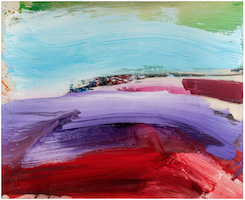
NEW YORK — There are modernist painters, and then there is Edward “Ed” Clark (American, 1926-2019). Not easily pigeonholed or categorized, the inventive painter was celebrated for his strong and decisive brushstrokes, bright colors and energetic compositions, as well as his unusual approaches to art-making.
Born in New Orleans, he grew up in Chicago and dropped out of high school at age 17 to serve in the armed forces. When his stint was over, he used the G.I Bill to enroll at the Art Institute of Chicago (1947-1951) to study figurative art. Afterwards, he moved to Paris to pursue further studies at L’Academie de la Grande Chaumiere and changed his focus to abstract art. Having grown up amid segregation in the South, Clark, an African American, reportedly found more creative freedom in Paris, where he was judged on his art, not the color of his skin.
After five years in Paris, he settled in New York City. It was there that he first employed a unique method of painting large canvases. Instead of wielding a painter’s brush, which only allowed him to cover small areas at a time, he used a janitor’s push broom. He was thus able to quickly sweep large swaths of paint across the canvas, usually in horizontal lines. He referred to this method as the “big sweep.”

He also gained fame for his shaped canvases, which he began to make in order to extend the canvas surface past the standard square or rectangular frame. In the 1960s, Clark began making oval canvases that he said were a better reflection of how the human eye saw. A 1972 Art News article credits him as the first artist to embrace shaped canvases.
While he was often described as an Abstract Expressionist, his artworks were more refined and a tad less abstract than the typical Ab-Ex style. Some of his works were suggestive of dreamy landscapes, or had humanistic elements.
“Clark has always been an inventive and creative artist, experimenting with techniques, like his innovative use of the push broom, for example, and his method of working on paper with dry pigment, inspired by the ‘pouring sand’ technique of the Pueblo tribe of the American Southwest,” according to the Ed Clark Studio website.

Clark’s interest in capturing differing qualities of light on canvas led him to travel around the world, including to the countries of Brazil, China and Nigeria. He found Brazil particularly inspiring, and during a 1988 visit to Bahia, the country’s fourth-largest state in terms of population, he created a series of works. A vibrant painting from his Bahia series realized $120,000 plus the buyer’s premium in April 2021 at Swann Auction Galleries. The deceptively simplistic canvas features just a few colors — pink, white and black — but is sophisticated in its execution.
Another favorite region was the American Southwest, where Clark became enamored with dry pigment painting as seen in Spatial Image III, a 1982 work that sold at Swann Auction Galleries for $280,000 plus the buyer’s premium in March 2022. A stay in Taos, N.M. led Clark to produce highly spontaneous paintings that featured brown, blue and red pigments. “He reinterpreted the oval forms that preoccupied him in the 1960s as glowing clouds of atmospheric color,” according to Swann Auction Galleries’ catalog description.

Clark’s late-career works are especially desirable, such as his 2006 painting Creation. It set an auction record for the artist at $600,000 plus the buyer’s premium at Hindman in May 2022. This acrylic painting, measuring 72 by 84in, reflects Clark’s mastery of color and composition. The colors on the canvas seem to explode like the birth of a universe. A rippling ocean-like blue wave with frothy white peaks dances across the top half of the canvas, while the bottom half features energetic reds and purples.
Among Clark’s dozens of solo exhibitions, a 2000 show at N’Namdi Gallery, titled China Series: Homage to the Year of the Dragon, focused on a group of works he developed after visiting China. One was an acrylic on canvas that made $280,000 plus the buyer’s premium at Black Art Auction in May 2020. Clark loved colors and the seductive nature of paint overall, but especially pink, which became one of his signature hues. This painting comprises fluid waves of rich colors — pinks, blues, whites and greens — lapping at each other with neat brushstrokes visible.

Artists who admire each other’s work often trade paintings, and Clark was noted to be a fan of American sculptor Albert LaVergne. The admiration was mutual, and the two were known to have exchanged works. Clark dedicated a 2009 acrylic to the artist, inscribing it “To Al Lavergne 6-2-10.” The painting is a mostly-neutral toned, minimalist scene accented by an orange splat of color that pops off the canvas. The painting sold for $170,000 plus the buyer’s premium in November 2020 at Black Art Auction.
Despite his talent and artistic innovation, Clark never drew widespread attention until the 1980s and only truly received his due in his final decade, when Chicago’s Art Institute presented a career-spanning retrospective in 2013-14. Today, Clark is well-recognized as a trailblazing artist whose work helped pave the way for many contemporary artists who came after him. Scholars and collectors continue to appreciate his originality, his experimental techniques, and his obvious love of pure color and form.



